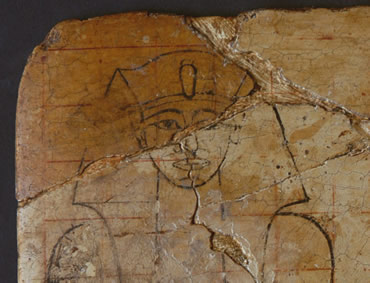Members of a delegation of archaeologists from Spain discovered the piece in Luxor in southern Egypt, at an amazing time (I doubt if they planned for it to come out just before Passover...)

The first full frontal portrait of an Egyptian pharaoh was recently discovered by archaeologists. The age of the painting is estimated at 3,500 years.
The piece was buried in a courtyard not far from a tomb in Luxor in southern Egypt, and was recently uncovered by a team of Spanish archaeologists. The portrait is painted on a wooden panel measuring approximately 50 x 30 centimeters and is unique. All other Egyptian paintings and drawings discovered so far show people in profile, because the artists believed that this would help them identify the subjects of the painting more easily.
Jose Manuel Galan, who discovered the painting together with his colleagues at the Institute of Philology, in Madrid, said that the painting was almost certainly created around 1400 BC. He believes that the painting shows Pharaoh Tuthmosis III or his mother Hatshepsut.
We can almost certainly say that the figure in the painting is royal, because he or she wears a trapezoidal garment known as a 'nemes' which is reserved exclusively for kings and queens.
This is the first time any pharaoh has been portrayed in this way, Galan told New Scientist. However, other figures depicted in ancient Egyptian art were seen in their full face such as gods, mythological figures and aliens. Galan believes that this is a rough drawing made by an art student, or that it is a draft for making a sculpture.
Marcel Maree, an Egyptologist at the British Museum in London, agrees with the second assessment. I'm sure this is a study for the purpose of carving a statue," he said, pointing to the presence of red squares in the painting. This means is also used by artists of our time, and helps the sculptor to transfer the image from the painting to the stone in which it will be sculpted.
Mari also agrees with the conclusions of the Spanish team regarding the dating and estimates that the figure in the painting is indeed Tuthmosis III. The portrait will be displayed in the museum in Luxor in the coming months.
